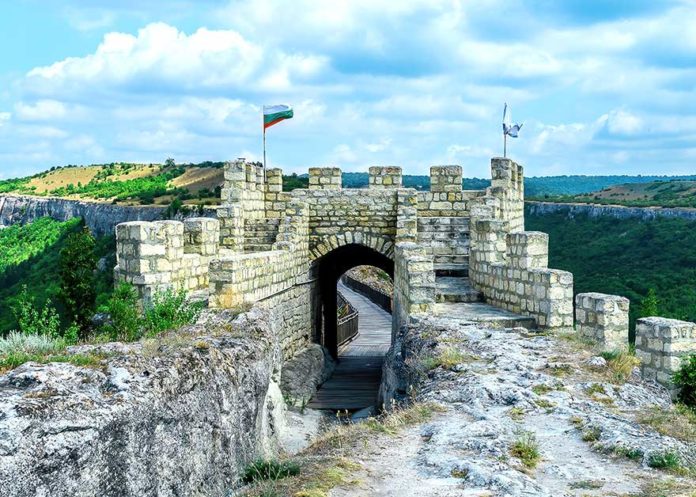The Ovech Fortress sits on a ship-shaped plateau surrounded by 11 to 25 meters tall cliffs. A narrow passage connects it to the nearby “Tabiite” plateau. The fortress’s main entrance, guarded by high walls, is linked to “Tabiite” by a 160-meter bridge. A moveable bridge was built over an 8-meter-long, 5-meter-deep trench at the entrance.
Legend says the fortress was equipped with colossal grain and food reserves stored in karst caves below it, providing sustenance during sieges. Its strategic location close to Varna was a significant reason for its development during the Bulgarian rule. Lacking a robust naval fleet, the Bulgarians used Ovech as a post to protect their medieval capitals from Byzantine invasions.
Today, the fortress preserves an array of features: the fully renovated bridge connecting it to “Tabiite”, numerous wells for water collection, including one 80-meter deep grain silos, the ruins of a three-nave single-apsis church – the center of the Ovech Eparchy, two single-nave single-apsis churches from the 12th-14th centuries, guard towers, a stone northern gate, the prisons of nobles, offenders, and prisoners of war, and the marble columns of Omurtag. Excavations have uncovered caves that have been inhabited since Antiquity.
Explore Ovech Fortress, a remnant of Bulgaria’s past symbolizing resilience and strategic brilliance.
Ovech Fortress History
It is believed that Provadia was founded as a Byzantine fortress against invasions from the north during the Byzantine period. It got the name Provaton, meaning “Sheep Fortress” in Greek. The Bulgarians of Asparuh adopted this name, and in all Bulgarian documents, the fortress is referred to as Ovech. Initially, it served a primarily defensive purpose but quickly became a significant administrative and military center with a permanent population. After the Bulgarians adopted Christianity, the fortress served as an episcopal residence.
Even though there is no definite evidence, Ovech likely existed during the First Bulgarian Kingdom. There are two inscriptions of Khan Omurtag regarding his campaigns against the Franks and Magyars, where the mentioned military leaders died.
In 1388, Ovech fell under Ottoman rule under the pressure of a 30,000-strong Turkish army led by Grand Vizier Chandarli Ali Pasha and Yahshi Bey, the son of Rumeli Beylerbey Kara Timurtash Pasha. The fortress was seized deceitfully at night following a truce.
In 1409, Ovech became the center of a rebellion led by Fruzhin, son of Ivan Shishman. In 1413, Musa, son of Bayazid I, reconquered the fortress and brutally dealt with the rebellious population. The Polish-Hungarian king Vladislav III Jagiello – Varnenchik attacked and destroyed the fortress in 1444. After his defeat at Varna, the Turks reoccupied the fortress, maintaining a small military garrison. The fortress began to lose its purpose, maintained by the Turks until the end of the 17th century. With Bulgaria becoming a deep hinterland of the empire, the fortress was abandoned. Its Bulgarian population founded the present-day town of Provadia.
Historical Importance
Ovech Fortress holds a unique place in Bulgarian history for several reasons:
- Strategic Importance: Its location offered strategic advantages. During the Bulgarian rule, the fortress acted as a protective outpost against Byzantine invasions. Its proximity to Varna, a critical coastal city, meant it played a crucial role in defending the inland Bulgarian capitals from maritime attacks.
- Cultural Significance: The fortress, with its architectural and archeological features, provides insight into different periods of Bulgarian history – the Byzantine period, the First Bulgarian Kingdom, and Ottoman rule. It showcases the evolution of administrative, military, and religious structures over centuries.
- Historical Events: Ovech Fortress was the center of significant events, such as the rebellion led by Fruzhin during Ottoman rule and its eventual destruction by the Polish-Hungarian king Vladislav III Jagiello – Varnenchik. These events reflect the changing power dynamics in the region.
- Surviving Heritage: Despite being subjected to invasions, destruction, and abandonment, the fortress’s remnants today, like the renovated bridge, wells, churches, and guard towers, serve as tangible links to the past, helping us understand and appreciate Bulgaria’s historical narrative.
The journey of the Ovech Fortress is a fascinating tale of resilience and transformation, reflecting the historical tides of the Bulgarian land. It stands as a testament to the varied and tumultuous history of the region.



